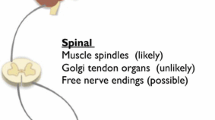Abstract
Comparisons of the EMG and myogram responses in a phasic stretch reflex between normal resting tension (control) and three pre-strain conditions show that (i) there is a positive, linear relationship between these two variables but the correlation coefficient decreases with increase in force of pre-strain, (ii) when the relationship is plotted, the regression lines for control and pre-strain separate but the slopes for the regressions are not dissimilar, (iii) there is a progressive decrease in the variance of responses with increase in force of pre-strain and (iv) there is a high product-moment correlation coefficient between the peak force of the myogram and the area of the myogram. Explanations for these results are discussed in terms of muscle spindle physiology.
Sommaire
Des comparaisons de réactions de l'E.M.G. et du myogramme dans un réflexe d'allongement phasique entre la tension normale au repos (contrôle) et trois conditions de prétension, montrent: (1) qu'il y a un rapport positif, linéaire entre ces deux variables, mais que le coefficient de corrélation décroît avec l'augmentation en puissance de la pré-tension; (2) quand le rapport est tracé, les lignes de régression pour le contrôle et la pré-tension se séparent, mais les inclinaisons pour les régressions ne sont pas dissimilaires; (3) il y a une diminution progressive dans la différence de réactions avec l'augmentation en force de la pré-tension; (4) il y a un grand coefficient de corrélation ‘produit-moment’ entre la force maximale du myogramme et la région du myogramme. Les explications de ces résultats sont discutées en termes de physiologie des fuseaux musculaires.
Zusammenfassung
Vergleiche der EMG und Myogrammreaktionen in einem phasischen Streckungsreflex zwischen normaler Ruhespannung (Kontrolle) und drei Zuständen vor einer Spannung zeigen dass: (1) eine positive lineare Verbindung zwischen diesen beiden Veränderlichen besteht, dass aber der Korrelationskoeffizient mit Vergrösserung der Kraft der Vorherspannung abnimmt; (2) die Regressionslinien für Kontrolle und Vorherspannung sich trennen, wenn das Verhältnis graphisch dargestellt wird, dass aber die Neigungen der Regressionen nicht unähnlich sind; (3) eine fortschreitende Abnahme in der Veränderung der Reaktionen mit Steigerung der Vorspannungskraft erfolgt; und (4) ein grosser Produkt-Moment Korrelations koeffizient zwischen der Spitzenkraft des Myogramms und der Fläche des Myogramms existiert. Erklärungen für diese Ergebnisse werden in Form von Muskelspindelphysiologie besprochen.
Similar content being viewed by others
References
Clarke, A. M. (1965a) The relationship between the electromyogram and the force of the isometric reflex response of normal human subjects.Nature (Lond.)208, 551–552.
Clarke, A. M. (1965b) Specifications and characteristics of a sound-proofed, electrically shielded and thermally insulated room.Aust. J. Psychol.17, 124–132.
Clarke, A. M. (1967a) Relationship between the electromyogram and the isometric reflex response under prestrain conditions in normal human subjects.Nature (Lond.)214, 1114–1115.
Clarke, A. M. (1967b) The effect of the Jendrassik manoeuvre on a phasic stretch reflex in normal human subjects during experimental control over supra-spinal influences.J. Neurol. Neurosurg. Psychiat.30, 34–42.
Clarke, A. M. (1967c) Motoneuron reflex response during intermittent visual stimulation as an indication of fusimotor activity.Physiol. Behav.2, 153–159.
Eldred, E., Granit, R. andMerton, P. A. (1953) Supraspinal control of the muscle spindles and its significance.J. Physiol.122, 498–523.
Jacobson, E. (1924) The technic of progressive relaxation.J. nerv. ment. Dis.60, 568–578.
McIntyre, A. K. (1951) Afferent limb of the myotatic reflex arc.Nature (Lond.)168, 168–169.
Magladery, J. W., Porter, W. E., Park, A. M. andTeasdale, R. D. (1951) Electrophysiological studies of nerve and reflex activity in normal man.Bull. Johns Hopkins Hosp.88, 499–561.
Merton, P. A. (1953) Speculations on the servocontrol of movement. In:Malcolm, J. L. andGray, J. A. B. (Eds.)The Spinal Cord, pp. 247–260. Ciba Foundation Symposium. Churchill Ltd., London.
Paillard, J. (1959) Functional organisation of afferent innervation of muscle studied in man by monosynaptic testing.Am. J. Phys. Med.38, 239–247.
Author information
Authors and Affiliations
Rights and permissions
About this article
Cite this article
Clarke, A.M. Electromyogram and myogram responses under pre-strain conditions in normal humans as an index of fusimotor sensitization of muscle spindles. Med. & biol. Engng. 10, 291–296 (1972). https://doi.org/10.1007/BF02474120
Issue Date:
DOI: https://doi.org/10.1007/BF02474120




